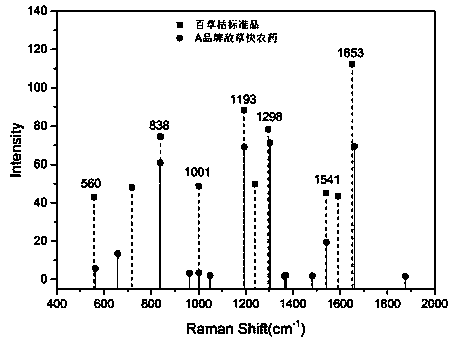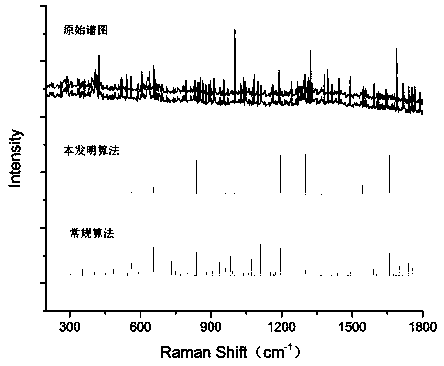Method for rapidly identifying true and false pesticides based on portable differential Raman technology
A portable and pesticide-based technology, applied in Raman scattering, material excitation analysis, etc., can solve problems such as accurate measurement of difficult and complex matrix samples, inability to form mature products, poor accuracy of sample reduction, etc., to achieve automatic screening and detection limit The effect of low and high accuracy
- Summary
- Abstract
- Description
- Claims
- Application Information
AI Technical Summary
Problems solved by technology
Method used
Image
Examples
Embodiment 1
[0025] Embodiment 1. Establish the Raman spectral library of pesticide standard products, specifically as follows.
[0026] Portable dual light source Raman spectrometer uses 785nm light source, 1nm spacing, single frequency output power 400mw, line width 0.06nm, spectral range: 180-2800cm -1 , the Raman spectrum scan time of the collected sample is 5 seconds.
[0027] Purchase common pesticide standard products (>99%) and conduct direct detection on samples. Through the difference algorithm software integrated into the Raman spectrometer, the two Raman spectrum characteristic parameters of the pesticide standard obtained by detection are subjected to difference and signal filtering to eliminate the interference of fluorescence and ambient light, and obtain the Raman spectrum of the pesticide standard Difference spectrogram data. By detecting a variety of pesticide standard substances, a Raman spectral database of pesticides was established.
Embodiment 2
[0028] Example 2. The detection of the commercially available pesticide Raman spectrum is as follows.
[0029] Commercially available pesticides used in the experiment were purchased from e-commerce platforms.
[0030] Portable dual light source Raman spectrometer uses 785nm light source, 1nm spacing, single frequency output power 400mw, line width 0.06nm, spectral range: 180-2800cm -1 , the Raman spectrum scan time of the collected sample is 10 seconds.
[0031] (1) Determination of commercially available pesticide diquat
[0032] The dosage form of brand A diquat pesticide is water agent, the product marked content is 200g / L, and the packaging is translucent white plastic bottle; the dosage form of brand B diquat pesticide is water agent, the product marked content is 200g / L, and the packaging is transparent plastic bottle.
[0033] The laser probe directly detects brand A and brand B pesticides through the plastic bottle, and through the differential algorithm software i...
Embodiment 3
[0042] Example 3. Verify the detection limit of the detection method, specifically as follows.
[0043] Diquat pesticide of brand B (200g / L, content about 20%) in Example 2 was diluted with pure water, and diluted into samples with 10%, 5%, 1%, 0.2%, and 0.05% of the active ingredient of diquat .
[0044] Samples of each concentration were filled into glass vials for direct detection. By the same method as the diquat pesticide in Example 2, the Raman spectrum differential spectrum data of samples with various concentrations were obtained.
[0045] The results showed that with the decrease of the effective components of diquat, the intensity of characteristic peaks of diquat gradually weakened, the number of characteristic peaks decreased, and the matching ratio decreased. The matching ratios of 10%, 5%, 1%, 0.2%, and 0.05% samples were 58%, 50%, 42%, 42%, and 17%, respectively. It can be seen that the detection limit of the commercially available pesticide diquat is 0.2%, w...
PUM
 Login to View More
Login to View More Abstract
Description
Claims
Application Information
 Login to View More
Login to View More - R&D
- Intellectual Property
- Life Sciences
- Materials
- Tech Scout
- Unparalleled Data Quality
- Higher Quality Content
- 60% Fewer Hallucinations
Browse by: Latest US Patents, China's latest patents, Technical Efficacy Thesaurus, Application Domain, Technology Topic, Popular Technical Reports.
© 2025 PatSnap. All rights reserved.Legal|Privacy policy|Modern Slavery Act Transparency Statement|Sitemap|About US| Contact US: help@patsnap.com



